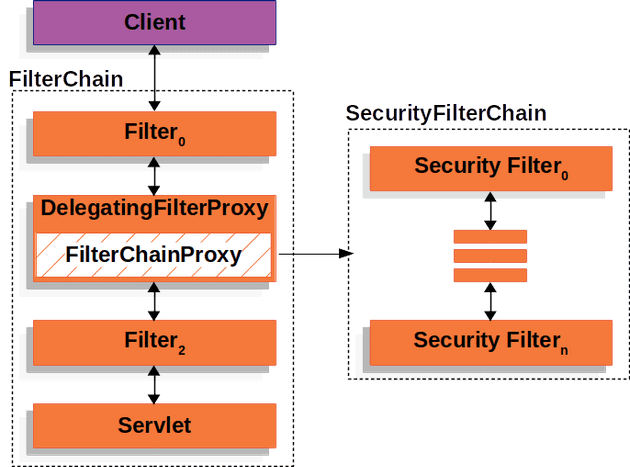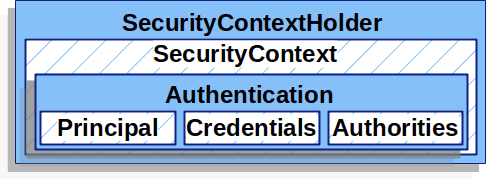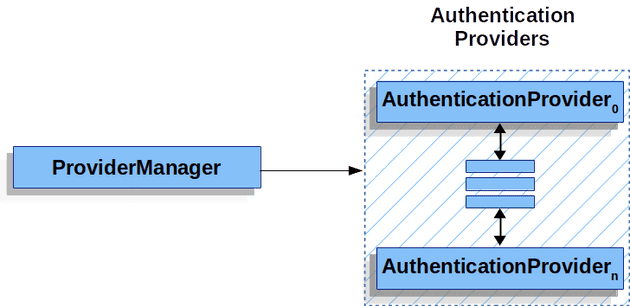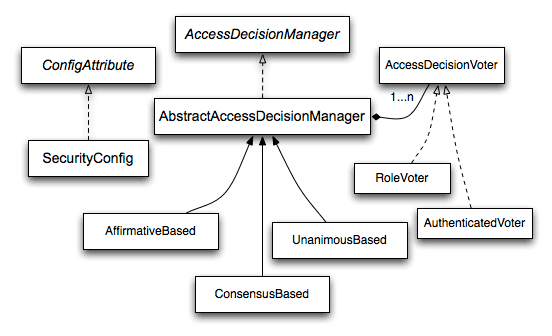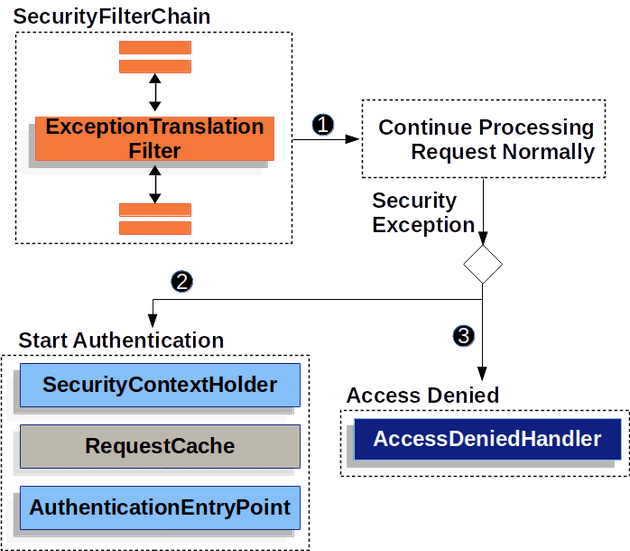Spring Security Architecture
서블릿 기반의 애플리케이션에서 스프링 시큐리티의 아키텍쳐를 알아본다. 스프링 시큐리티는 서블릿 기반 애플리케이션에서는 필터 기반으로 동작을 한다.
Security Filter
서블릿 필터에서는 스프링에서 구현된 빈을 직접 사용할 수 없는데,
둘 사이의 브릿지 역할을 하여 필터 처리를 빈에게 위임하는 것이 DelegatingFilterProxy이다.
그리고 스프링 시큐리티에서는 이를 이용하여 FilterChainProxy 라는 빈을 통해 서비스를 제공한다.
스프링 시큐리티가 제공하는 전체 필터를 순서대로 나열한 목록은 아래와 같다. 정해진 순서대로 처리되기에 전후 관계를 파악해야하는 것이 중요하다.
- ChannelProcessingFilter
특정 채널을 통한 요청만을 처리하게 한다. 가장 흔한 예제는 URL 요청은 HTTP 또는 HTTPS를 통해 발생할 수 있는데 HTTPS 요청만 처리하도록 강제하는 것이다. - WebAsyncManagerIntegrationFilter
Spring MVC에서 Async를 사용할 때, 생성된 다른 스레드에서도 Security Context를 공유할 수 있도록 처리한다. - SecurityContextPersistenceFilter
로그인 이후 여러 자원에 접근 가능하도록 HTTP Session을 기반으로 기존의 Security 정보를 읽어온다. Spring Session과 연동 가능하다. -
HeaderWriterFilte
Response Header에 시큐리티 관련 헤더 값을 추가해준다.- XContentTypeOptionsHeaderWriter: Mime Snipping 공격을 방어한다.
- XXssProtectionHeaderWriter: 브라우저에 내장된 XSS 필터를 적용한다.
- CacheControlHeadersWriter: 캐시 히스토리의 취약점을 방어한다.
- HstsHeaderWriter: https만 허용한다.
- XFrameOptionsHeaderWriter: clickjacking 공격을 방어한다.
- CorsFilter
CORS 요청에 대한 처리를 한다. - CsrfFilter
CSRF 방어를 위한 검증을 한다. - LogoutFilter
로그아웃 요청을 처리한다. 세션 무효화, Remember-me 인증 정리, SecurityContextHolder를 비우는 등의 작업이 이루어진다. - OAuth2AuthorizationRequestRedirectFilter
- Saml2WebSsoAuthenticationRequestFilter
- X509AuthenticationFilter
X.509 인증서를 통한 인증을 처리한다. - AbstractPreAuthenticatedProcessingFilter
SiteMinder, Java EE Security와 같은 외부 인증이 이루어진 요청에 대한 인증 처리를 한다. - CasAuthenticationFilter
CAS(Central Authentication Service) 기반 인증을 처리한다. - OAuth2LoginAuthenticationFilter
OpenId Connect, Non-Standard OAuth 2.0과 같은 OAuth 2.0 기반 인증을 처리한다. - Saml2WebSsoAuthenticationFilter
SAML 2.0 기반 인증을 처리한다 - UsernamePasswordAuthenticationFilter
폼 기반(Username, Password) 인증을 처리한다. - OpenIDAuthenticationFilter
OpenId 기반 인증을 처리한다. - DefaultLoginPageGeneratingFilter
기본 로그인을 처리하는 폼 화면을 만들어주는 역할을 한다. 커스텀 페이지를 생성할 경우 사라진다. - DefaultLogoutPageGeneratingFilter
기본 로그아웃을 처리하는 폼 화면을 만들어주는 역할을 한다. 커스텀 페이지를 생성할 경우 사라진다. - ConcurrentSessionFilter
사용자가 한 번에 가질 수 있는 활성 세션의 수를 제어한다. - DigestAuthenticationFilter
Digest 기반 인증을 처리한다. - BearerTokenAuthenticationFilter
JWT, Opaque token과 같은 Bearer Token 기반 인증을 처리한다. - BasicAuthenticationFilter ‘username:password’를 base64로 인코딩하여 헤더에 포함시키는 HTTP 기본 인증을 처리한다.
- RequestCacheAwareFilter
해당 요청과 관련된 캐싱이 되어 있으면 캐싱된 내용으로 처리한다. 예를들어, 특정 URL에 접근했을 때 인증이 안된 상태라면 로그인 화면으로 리다이렉트 되는데, 정상적으로 로그인하면 원래 요청한 URL로 자동으로 넘어간다. - SecurityContextHolderAwareRequestFilter
Servlet 3의 보안 관련 API들 직접 사용할 때 스프링 시큐리티 기반으로 사용할 수 있도록 연동해주는 역할을 한다. - JaasApiIntegrationFilter
JAAS(Java Authentication and Authorization Service) 인증을 처리한다. - RememberMeAuthenticationFilter
쿠키 또는 데이터베이스 토큰 저장 등을 활용하여 세션이 만료되더라도 로그인 상태를 유지할 수 있게한다. 자동 로그인 같은 기능에 사용된다. - AnonymousAuthenticationFilter
요청에 인증 정보가 null이라면 익명 사용자를 나타내는 객체를 생성하여 인증 정보에 주입한다. - OAuth2AuthorizationCodeGrantFilter
- SessionManagementFilter
Session에 대한 정책을 체크한다. 세션 고정 보호, 타임아웃 처리, 동시에 열 수 있는 최대 세션 개수 등을 설정할 수 있다. - ExceptionTranslationFilter
아래FilterSecurityInterceptor를 감싸고 있으며 해당 필터에서 인증과 인가에 대한 예외인AuthenticationException,AccessDeniedException가 발생하면 처리를 한다. 인증이 필요한 자원에 인증 없이 접근을 할 때 로그인 페이지로 리다이렉트 해주거나, 권한이 없는 자원에 접근을 할 때는 에러 페이지로 리다이렉트 해주는 등의 역할을 한다. - FilterSecurityInterceptor
권한 정보를 기반으로 해당 자원에 대해 Access Control을 한다. - SwitchUserFilter
리눅스의 ‘su’ 명령어와 같이 사용자 전환 처리 역할을 한다.
Authentication
스프링 시큐리티는 수 많은 필터를 기반으로 다양한 인증 방식을 처리할 수 있다. 그 중 가장 많이 사용되는 방식인 Username, Password 기반 인증의 구조를 알아본다.
해당 인증 방식은 폼 기반 Authentication, Http Basic Authehntication, Digest Authentication을 처리할 수 있다.
Username, Password 기반 방식 인증 아키텍쳐
SecurityContextHolder, SecurityContext, Authentication
SecurityContextHolder는 인증된 사용자의 세부 정보를 저장하고 있으며 내부의 값이 존재한다면 인증된 사용자임을 의미한다.
SecurityContext는 홀더 내부에서 Authentication를 포함하고 있는 객체이며,
Authentication 객체는 인증된 사용자의 정보를 포함하고 있다.
principal: ‘인증한 사용자가 누군가?’ 에 해당되는 정보이며, 해당 방식 인증 시에는UserDetailService에서 반환한UserDetails객체를 나타낸다.authorities:GrantAuthoritiy객체는AuthenticationManager가 부여한 권한 등급을 나타낸다.credentials: 인증한 사용자의 암호를 나타낸다.
가장 상위 객체인 SecurityContextHolder는 ThreadLocal 을 통해 관리되고 있기에,
별도의 파라미터 없이 동일 스레드 내부라면 아래와 같이 접근하여 사용할 수 있다.
public class SampleService {
public void sample() {
// 아래와 같이 접근하여 사용 가능
SecurityContext context = SecurityContextHolder.getContext();
Authentication authentication = context.getAuthentication();
String username = authentication.getName();
Object principal = authentication.getPrincipal();
Collection<? extends GrantedAuthority> authorities = authentication.getAuthorities();
}
}UsernamePasswordAuthenticationToken
요청의 HttpServletRequest 로 부터 해당 방식 인증을 위해 인증 정보인 Authentication 객체를 생성한다.
AuthenticationManager
각 Spring Security Filter가 인증을 수행하는 방법을 정의하고 있는 부분이며 넘어온 Authentication 정보가 유효한 인증 정보인지 확인하는 역할을 한다.
Authentication authentication(Authentication authentication) throws AuthenticationException;이 인터페이스는 하나의 메서드만 구현되어 있다.
필요에 맞게 직접 구현할 수도 있지만 대체로 그럴 일은 없으며, 이를 구현하고 있는 ProviderManager를 주로 사용한다.
ProviderManager
AuthenticationManager의 구현체이다.
이는 여러 개의 AuthenticationProvider 을 가지고 있으며 각각 Form 인증, OAuth 인증 등 요청에 맞는 인증 수행 로직을 포함하고 있다.
이 중에 적합한 AuthenticationProvider 을 찾아 인증 역할을 위임한다.
인증 과정에서 DisabledException(비활성화 계정), BadCredentialsException(잘못된 비밀번호) LockedExcpetion(잠긴 계정) 등의 예외를 생성할 수 있다.
최종적으로, 인증이 되면 Authentication 객체를 반환하며 SecurityContextHolder 에 저장되어 사용할 수 있게 된다.
AuthenticationProvider
ProviderManager에 주입되어 사용되며, 특정 유형의 인증을 수행한다.
샘플에서는 DaoAuthenticationProvider를 사용하여 넘어온 Username과 Password가 유효한 것인지 검증을 하는 부분이다.
UserDetailsService
데이터베이스에 저장되어 있는 사용자 인증 정보를 가져오는 역할을 하는 서비스이다.
UserDetailsService 인터페이스를 구현하면 되고, DaoAuthenticationProvider 에서는 해당 객체를 활용해 인증 정보를 가져온다.
구현이 필요한 loadUserByUsername() 메서드는 UserDetails 객체를 반환하며,
이는 스프링 시큐리티가 사용하고 있는 Authentication 객체 사이의 어댑터 역할을 한다.
@Service
public class UserRepositoryUserDetailService implements UserDetailsService {
private final UserRepository userRepository;
@Autowired
public UserRepositoryUserDetailService(UserRepository userRepository) {
this.userRepository = userRepository;
}
@Override
public UserDetails loadUserByUsername(String username) throws UsernameNotFoundException {
User user = userRepository.findByUsername(username);
if(user != null){
return user;
}
throw new UsernameNotFoundException("User " + username + " not found");
}
}인증 정보가 데이터베이스에 저장되 있고, SQL Mapper나 ORM 같은 Persistence Framework를 사용하는 경우에는 이 방식으로 직접 구현하는 것이 일반적이다.
하지만 이 외에도 Storage에 따라 UserDetailsService 가 자동 구현되도록할 수 있다.
| Storage | Description |
|---|---|
| Inmemory 방식 | 사용자 정보가 변경 없이 사전 정의된 계정만 사용된다면 인증 정보를 메모리에 올려둔다 |
| JDBC 방식 | org/springframework/security/core/userdetails/jdbc/users.ddl에 정의된 기본 스키마를 기본으로 인증처리를 한다 |
| LDAP 방식 | LDAP(Lightweight Directory Access Protocol) 기반으로 인증처리를 한다 |
Authorization
스프링 시큐리티에서는 인증 방법과는 완전히 별개로 인가에 관한 룰을 정할 수 있다.
인증 과정에서 발생한 Authentication 객체에는 권한 정보인 GratedAuthority 객체를 가지고 있다.
이 객체는 권한 정보를 나타내며 스프링 시큐리티에서는 하나의 문자열로 권한을 표현하는 SimpleGrantedAuthority를 기본 구현체로 제공한다.
인가에 대한 판단은 필터 중 AbstractSecurityInteceptor의 구현체인 FilterSecurityInterceptor에서 진행한다. 이 인터셉터는 AccessDecisionManager 를 호출하며 인증 정보에 담긴 GratedAuthority를 기반으로 해당 리소스에 대한 접근 여부를 결정한다.
AccessDecisionManger는 인터페이스며 아래 3개의 메서드를 구현한다.
void decide(
Authentication authentication,
Object secureObject,
Collection<ConfigAttribute> attrs
) throws AccessDeniedException;
boolean supports(ConfigAttribute attribute);
boolean supports(Class clazz);이를 적절한 스펙을 가지고 직접 구현해도 되지만 스프링 시큐리티에서는 투표 기반 전략을 가지며 이에 관련된 구현체들을 제공한다.
먼저, 접근 허용/거부를 판정하는 AccessDecisionVoter가 여러 개 존재할 수 있는데 이는 AccessDecisionManager와 동일한 메서드를 구현하고 있는 인터페이스이다. 이들은 각각 판단 결과가 거부라면 AccessDeniedException를 발생시킨다.
그리고 이들은 직접 구현한 커스텀을 제외하고는 2가지가 존재한다.
| Name | Description |
|---|---|
RoleVoter |
전달된 ConfigAttribute에 ‘ROLE_’ 로 시작하는 속성이 있을 때 투표를 하며 그렇지 않으면 기권한다. 일치하면 접근 허용하며 일치하지 않으면 접근을 거부한다. |
AuthenticationVoter |
인증하지 않은 익명 사용자, remember-me를 통한 인증 등을 구분하여 접근 여부를 결정한다. |
Spring Mvc에서는 각 HttpServletRequest에 대한 룰을 아래 페이지를 참조하여 설정할 수 있다.
그리고 이 투표 결과를 모두 모아 최종 결정을 하는 3개의 AccessDecisionManger 구현체가 존재한다.
| Name | Description |
|---|---|
AffirmativeBased |
디폴트 값. 여러 Voter 중 한 명이라도 허용하면 접근 허용 |
ConcensusBased |
Voter들의 허용, 거부에 따른 다수결 판정 |
UnanimousBase |
모든 Voter가 허용해야 접근 허용 |
최종 결과가 접근 거부라면 후속 작업을 ExceptionTranslationFilter 에서 처리된다.
이 필터는 아래 코드처럼 FilterSecurityInteceptor를 감싸고 있다.
// pseudo code
try {
// FilterSecurityInterceptor 또는 Method Security 호출
} catch (AccessDeniedException | AuthenticationException ex) {
if (!authenticated || ex instanceof AuthenticationException) {
startAuthentication();
} else {
accessDenied();
}
}만약 AuthenticationException라면 먼저 SecurityContextHolder를 비우고 현재 요청 정보를 RequestCache를 통해 저장한다.
그리고 AuthenticationEntiryPoint를 통해 Credential을 요구하는데, 이는 Username/Password 방식이라면 로그인 페이지로 리다이렉트 된다. 만약 여기서 인증에 성공하면 캐시에 저장된 원래 요청을 처리한다.
AccessDeniedException라면 그 처리를 AccessDeniedHandler에게 위임하게 된다.
참고
- Spring Security Reference
- Topical Guide | Spring Security Architecture
- Craig Walls, Spring in Action 5/E, 심재철, 제이펍
